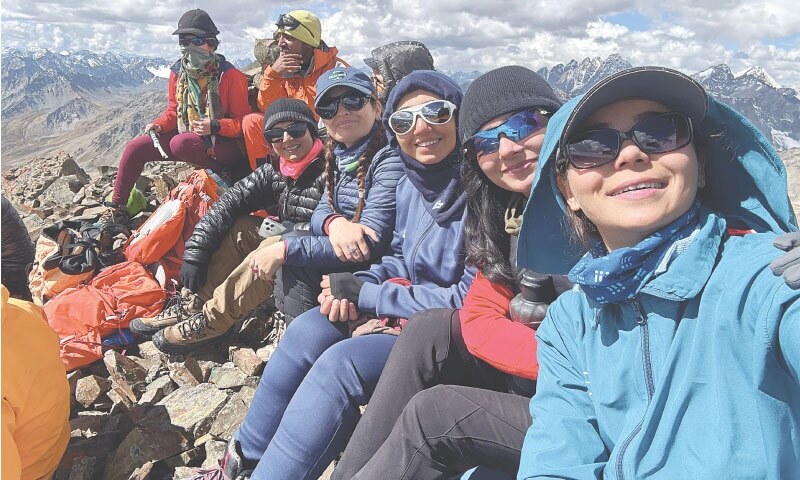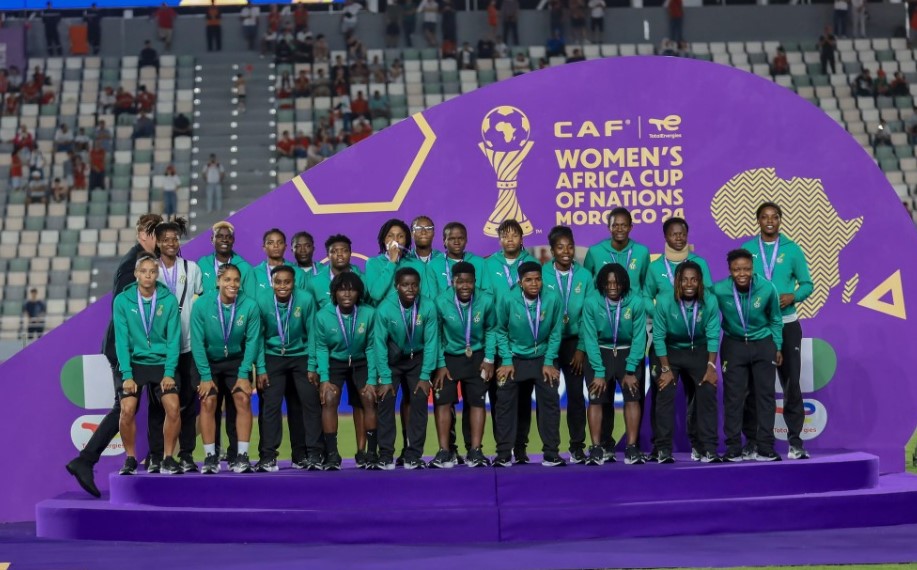Technology
MOUNTAINEERING: SISTERS OF THE SUMMIT
"I' ve climbed many peaks, including several 6,000ers,” Bibi ‘Zoni’ Afzoon Aslam, team leader of the women’s expedition to Bari La Peak (5,400m) that took place last month told me. “But this was a new experience for me — to lead nine women from different parts of the country.” I was one of those nine women.
Bibi Afzoon, or Zoni as she is fondly called, is a well-regarded mountaineer and guide from Gilgit-Baltistan. She was a part of the women’s expedition to K2 (2024) as well. “When I looked at the faces of the girls approaching the summit one by one, I was so happy,” she adds, “I’m very proud of us and that we can all come together and rise as one unit.”
Organised by the Alpine Club of Pakistan under its new management — Maj Gen Irfan Arshad (president) and Ayaz Shigri (general secretary) — the women’s expedition to Bari La was the first of its kind. Never before had there been an expedition where women from across the country — Sindh (yours truly), Balochistan (Laraib Batool), Khyber Pakhtunkhwa (Marya Bangash), Punjab (Bismah Hassan and Iqra Jillani), Azad Kashmir (Mona Khan), Islamabad Capital Territory (Shahreen) and Gilgit Baltistan (Bibi ‘Zoni’ Afzoon Aslam and Zeba Shigri) — had come together to climb one mountain.
We also had Amina Chaudhry in the team, who was climbing while filming the entire expedition and flying a drone at the summit as well.
In a first-of-its-kind expedition, 10 women from every region of Pakistan came together to climb the 5,400m Bari La Peak. Eos presents a first-hand account…
For those of us that arrived early, we got to visit the Sadpara Mountaineering School, where we were taught how to rappel off a 50m ‘lower’ top — only for the extremely brave adrenaline junkies out there. We also had a traditional Balti spread at Musa and Ali Sadpara’s house — two brothers that have summited all five of Pakistan’s highest peaks.
Unfortunately, about a day before our expedition was due to begin, singer Quratulain Baloch was attacked and injured by a brown bear in Deosai National Park. She has since recovered from her injuries but, in the wake of the incident, camping outside of designated spots — where hospitality services were officially available — was strictly forbidden.
Bari La peak is well outside of that area, which meant we would not be able to set up camp at the base of the mountain (which is at 4,700m) or spend the night there. Our base remained at the official campsite (at 4,000m) under Ali Malik peak, throughout our expedition.
We would have to find another way to acclimate. This would include a several hours- and 12km-long trek in the rain to Talkhumbo Lake and back, bringing us up to an altitude of 4,300m for a few minutes in the freezing cold. And that was about it for our acclimatisation.
The team leading us comprised the best of the best. Other than Zoni Aslam, we had one of Pakistan’s most accomplished mountaineers, Sajid Sadpara — son of the legendary Ali Sadpara and who has so far summited nine of the world’s 14 highest mountains without the use of supplemental oxygen — accompanying us.
Then, there was Ashraf Sadpara, son of another legendary mountaineer, Ali Raza Sadpara. Ashraf has summited all five of Pakistan’s peaks over 8,000m and has conducted numerous rescues at these 8,000m peaks. Fida Ali Shigri, our third main guide, is a living legend as well. He has summited all of Pakistan’s peaks over 8,000m multiple times (some of these attempts were without supplemental oxygen) and has summited Mount Manaslu in Nepal as well.
How hard was this compared to climbing an 8,000er? I asked Sajid Sadpara. “You can’t even compare this to an 8,000er because this is at 5,400m,” he responded incredulously. “It’s a hiking peak. Still, it was fun. It was a good experience climbing with women from all over Pakistan.”
Summit day started early. Our wake-up call was at 4am but by 3.30am the camp was echoing with the sounds of Sajid singing happily, making it impossible to get a few extra minutes of shut-eye. “I’m always excited on summit day!” he remarked.
By 5am, we were off in our 4x4s to the base of Bari La Peak, which began at 4,700m — a big jump in altitude, especially for someone like me, who had arrived only a few days prior from sea level or 0m. “This is the first time in my life I am driving to a summit push,” joked Sajid Sadpara. Consequently, our 4x4s were also good-naturedly dubbed “the summit vehicles.”
Very soon after reaching the base of the mountain, we all took off. We had additional support this time — our expedition logistics company head, Sharif Sadpara and guide-in-training Muhammad Qubad Sadpara were also with us, making the ratio almost one guide for every two team climbers.
Bari La has two summits — the fore summit, a snowy top at 5,350m and the ‘true’ summit, a somewhat steep and rocky climb to 5,400m. Most people end up doing the fore summit but not our group — Sajid and Ashaf brought rope with them that they fixed to the true summit to make it safer for the more inexperienced climbers. “[Because] the summit is the summit,” said Sajid simply.
The first on top was the incredible trio of Zoni Aslam, Zeba Shigri (one of Pakistan’s first rock-climbing instructors) and Bismah Hassan (a very experienced professional mountain trekking guide). It took about an hour or so after that for the rest of the entire group to make it to the top.
Except me — I had to turn back at 5,000m. I was suffering from symptoms of altitude sickness — nausea, which had already started by the time we reached the base, worsening headache and finally dizziness. I’ve summited a much higher peak before — Mt Kilimanjaro (5,895m) in Tanzania, Africa, and felt fine at that summit, so I knew this was not normal. It just wasn’t my day.
I was admittedly gutted, but focused my energies on keeping an eye on the mountain and keeping track of returning climbers, organising water and refreshments from our lunch and putting together a welcoming party. Several of the girls came down and cried from joy and a sense of immense accomplishment, especially those for whom it was a first summit.
“This was a priceless opportunity for me to prove myself,” said Zeba, “It was also a journey of discovering my true self and my identity as a human being. Most of my mountain journeys had been with people I’d known for years, but joining a brand new group and working together as a team on a single mission was an entirely new experience.”
She added: “This expedition taught me that real success lies in supporting one another, building trust, and uplifting each other. As women, we are at our strongest when we stand together and move forward as one.”
None of the girls that were a part of the expedition are going again to Bari La. There are many more peaks to summit. The mountaineering bug has bitten all of us, for life.
The writer is a journalist,
an award-winning documentary filmmaker and radio correspondent.
Instagram: @madeeha.syed
Published in Dawn, EOS, October 26th, 2025
"I' ve climbed many peaks, including several 6,000ers,” Bibi ‘Zoni’ Afzoon Aslam, team leader of the women’s expedition to Bari La Peak (5,400m) that took place last month told me. “But this was a new experience for me — to lead nine women from different parts of the country.” I was one of those nine women.
Bibi Afzoon, or Zoni as she is fondly called, is a well-regarded mountaineer and guide from Gilgit-Baltistan. She was a part of the women’s expedition to K2 (2024) as well. “When I looked at the faces of the girls approaching the summit one by one, I was so happy,” she adds, “I’m very proud of us and that we can all come together and rise as one unit.”
Organised by the Alpine Club of Pakistan under its new management — Maj Gen Irfan Arshad (president) and Ayaz Shigri (general secretary) — the women’s expedition to Bari La was the first of its kind. Never before had there been an expedition where women from across the country — Sindh (yours truly), Balochistan (Laraib Batool), Khyber Pakhtunkhwa (Marya Bangash), Punjab (Bismah Hassan and Iqra Jillani), Azad Kashmir (Mona Khan), Islamabad Capital Territory (Shahreen) and Gilgit Baltistan (Bibi ‘Zoni’ Afzoon Aslam and Zeba Shigri) — had come together to climb one mountain.
We also had Amina Chaudhry in the team, who was climbing while filming the entire expedition and flying a drone at the summit as well.
In a first-of-its-kind expedition, 10 women from every region of Pakistan came together to climb the 5,400m Bari La Peak. Eos presents a first-hand account…
For those of us that arrived early, we got to visit the Sadpara Mountaineering School, where we were taught how to rappel off a 50m ‘lower’ top — only for the extremely brave adrenaline junkies out there. We also had a traditional Balti spread at Musa and Ali Sadpara’s house — two brothers that have summited all five of Pakistan’s highest peaks.
Unfortunately, about a day before our expedition was due to begin, singer Quratulain Baloch was attacked and injured by a brown bear in Deosai National Park. She has since recovered from her injuries but, in the wake of the incident, camping outside of designated spots — where hospitality services were officially available — was strictly forbidden.
Bari La peak is well outside of that area, which meant we would not be able to set up camp at the base of the mountain (which is at 4,700m) or spend the night there. Our base remained at the official campsite (at 4,000m) under Ali Malik peak, throughout our expedition.
We would have to find another way to acclimate. This would include a several hours- and 12km-long trek in the rain to Talkhumbo Lake and back, bringing us up to an altitude of 4,300m for a few minutes in the freezing cold. And that was about it for our acclimatisation.
The team leading us comprised the best of the best. Other than Zoni Aslam, we had one of Pakistan’s most accomplished mountaineers, Sajid Sadpara — son of the legendary Ali Sadpara and who has so far summited nine of the world’s 14 highest mountains without the use of supplemental oxygen — accompanying us.
Then, there was Ashraf Sadpara, son of another legendary mountaineer, Ali Raza Sadpara. Ashraf has summited all five of Pakistan’s peaks over 8,000m and has conducted numerous rescues at these 8,000m peaks. Fida Ali Shigri, our third main guide, is a living legend as well. He has summited all of Pakistan’s peaks over 8,000m multiple times (some of these attempts were without supplemental oxygen) and has summited Mount Manaslu in Nepal as well.
How hard was this compared to climbing an 8,000er? I asked Sajid Sadpara. “You can’t even compare this to an 8,000er because this is at 5,400m,” he responded incredulously. “It’s a hiking peak. Still, it was fun. It was a good experience climbing with women from all over Pakistan.”
Summit day started early. Our wake-up call was at 4am but by 3.30am the camp was echoing with the sounds of Sajid singing happily, making it impossible to get a few extra minutes of shut-eye. “I’m always excited on summit day!” he remarked.
By 5am, we were off in our 4x4s to the base of Bari La Peak, which began at 4,700m — a big jump in altitude, especially for someone like me, who had arrived only a few days prior from sea level or 0m. “This is the first time in my life I am driving to a summit push,” joked Sajid Sadpara. Consequently, our 4x4s were also good-naturedly dubbed “the summit vehicles.”
Very soon after reaching the base of the mountain, we all took off. We had additional support this time — our expedition logistics company head, Sharif Sadpara and guide-in-training Muhammad Qubad Sadpara were also with us, making the ratio almost one guide for every two team climbers.
Bari La has two summits — the fore summit, a snowy top at 5,350m and the ‘true’ summit, a somewhat steep and rocky climb to 5,400m. Most people end up doing the fore summit but not our group — Sajid and Ashaf brought rope with them that they fixed to the true summit to make it safer for the more inexperienced climbers. “[Because] the summit is the summit,” said Sajid simply.
The first on top was the incredible trio of Zoni Aslam, Zeba Shigri (one of Pakistan’s first rock-climbing instructors) and Bismah Hassan (a very experienced professional mountain trekking guide). It took about an hour or so after that for the rest of the entire group to make it to the top.
Except me — I had to turn back at 5,000m. I was suffering from symptoms of altitude sickness — nausea, which had already started by the time we reached the base, worsening headache and finally dizziness. I’ve summited a much higher peak before — Mt Kilimanjaro (5,895m) in Tanzania, Africa, and felt fine at that summit, so I knew this was not normal. It just wasn’t my day.
I was admittedly gutted, but focused my energies on keeping an eye on the mountain and keeping track of returning climbers, organising water and refreshments from our lunch and putting together a welcoming party. Several of the girls came down and cried from joy and a sense of immense accomplishment, especially those for whom it was a first summit.
“This was a priceless opportunity for me to prove myself,” said Zeba, “It was also a journey of discovering my true self and my identity as a human being. Most of my mountain journeys had been with people I’d known for years, but joining a brand new group and working together as a team on a single mission was an entirely new experience.”
She added: “This expedition taught me that real success lies in supporting one another, building trust, and uplifting each other. As women, we are at our strongest when we stand together and move forward as one.”
None of the girls that were a part of the expedition are going again to Bari La. There are many more peaks to summit. The mountaineering bug has bitten all of us, for life.
The writer is a journalist,
an award-winning documentary filmmaker and radio correspondent.
Instagram: @madeeha.syed
Published in Dawn, EOS, October 26th, 2025



